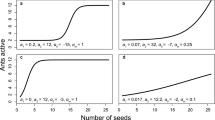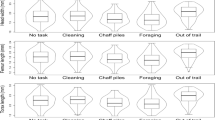Summary.
A study was made of variations in size-matching in M. barbarus during transport of food to the nest. The effects of various factors were studied. Ants showed low selectivity at the food source, with both natural and with baits. This low initial selectivity tended to increase as seed fragments were transported along the foraging-trail to the nest; by the end of the trail, a very high degree of correlation was recorded between ant mass and load mass (r = 0.64, p < 0.001). This increase in correlation between ant mass and load mass may be brought about by exchanges of loads between workers along the length of the foraging trail. We have shown that there exists an inverse relationship between the recruitment rate to a food patch and size-matching. The most important population foragers factors affecting size-matching are the variation in load size, followed by the variation in worker size.
Similar content being viewed by others
Author information
Authors and Affiliations
Additional information
Received 31 March 2000; revised 18 January 2001; accepted 26 January 2001
Rights and permissions
About this article
Cite this article
Reyes-López, J., Fernández-Haeger, J. Some factors determining size-matching in the harvester ant Messor barbarus: food type, transfer activity, recruitment rate and size-range. Insectes soc. 48, 118–124 (2001). https://doi.org/10.1007/PL00001753
Issue Date:
DOI: https://doi.org/10.1007/PL00001753




